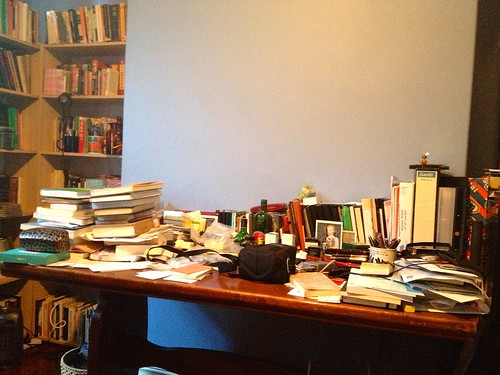To write a lot, one needs to sit down and write.
That’s the gist of the book How to Write a Lot by Paul J. Silvia (APA, 2007).
Silvia acknowledges that writing is hard. He says that to write productively you need to take certain “actions that you aren’t doing but could easily do: making a schedule, setting clear goals, keeping track of your work, rewarding yourself, and building good habits.” (pp.2-3) That’s the sum of the book, really, but of course you don’t stop reading at that point.
Silvia identifies four “Specious Barriers to Writing A Lot”:
- I need to find the time to write. This Specious Barrier, Silvia points out, is comforting, but ultimately, false. He points out that we don’t have any trouble finding time for all the things we consider important, like going to work. These tasks are part of our daily routines and we just do them. “Instead of finding time to write, allot time to write.” Haven’t we all come across this Specious Barrier, and its antidote, before? (“I don’t have the time to learn about Web 2.0…”) “The secret is the regularity, not the number of days or the number of hours.” (p.13) Allot the time, make a schedule, and stick to it.
- I need to do more reading/research/analysis before I can write. Well, Silvia says, if you need to do reading/research/analysis, do it in your allotted/scheduled time.
- I need a new computer/printer/chair/room before I can write. MY current excuse is that I need to tidy my desk (see picture) before I can write. My solution: I moved my Macbook to the dining table. “Equipment will never help you write a lot; only making a schedule and sticking to it will make you a productive writer.” (p.22)
- I need inspiration before I can write. “If you believe that you should write only when you feel like writing, ask yourself some simple questions: How has this strategy worked so far? Do you feel stressed about finding time to write or about completing half-finished projects? Do you sacrifice your evenings and weekends for writing?” (p.23) Silvia cites a study by Boice (1990) that showed that not only do people who schedule time to write, write more, they also have more ideas for writing. “Writing breeds good ideas for writing.” (p.24)
I found his arguments here convincing, having done this before: I’ve set up schedules for myself to do certain things. Schedules work for me. I can’t think why I hadn’t figured out that I could do this for writing!
I really identified with Silvia’s description of the “binge writer” (p.14):
After intending to write, procrastinating, and feeling guilty and anxious about procrastinating, binge writers finally devote a Saturday to nothing but writing. This creates some text and alleviates the guilt and the binge-writing cycle begins anew. Binge writers spend more time feeling guilty and anxious about not writing than schedule followers spend writing. When you follow a schedule, you no longer worry about not writing, complain about not finding time to write, or indulge in fantasies about how much you’ll write over summer. Instead, you write during your allotted times and then forget about writing. We have better things to worry about than writing. I worry about whether I drink too much coffee or whether my dog drinks from the fetid backyard pool, but I don’t worry about finding time to write this book: I know that I’ll do it tomorrow at 8:00 a.m.
This was a short, well-written book that was a pleasure to read, despite its somewhat dry topic. It was a pleasure to read mainly because Silvia wrote in a conversational style and avoided all the writing pitfalls we are told to avoid: he used minimal jargon and the active voice wherever possible.
I’m inspired, and given that I have a few writing projects and ideas to work through in the coming months, I need a writing schedule! (You’ve just read part of its by-product…)
Thanks to Hugh Rundle for the book recommendation.

One Comment
love your desk 🙂